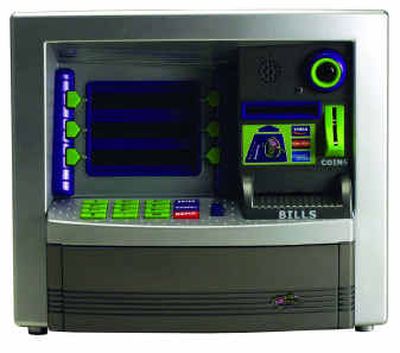Toy ATM a hot commodity

WASHINGTON — Somewhere in China, frantic factory workers cannot make enough toy automatic teller machines for clamoring American children.
“I wish every kid in America could have an ATM,” says Michael Searl, the onetime stockbroker who created the Youniverse ATM Machine, a highly evolved piggy bank that receives and dispenses real cold cash, not that fake play stuff. “Why wouldn’t I want every kid to have one?”
Tweens and beyond can insert the supplied ATM card into the silver machine, punch in their PIN, be greeted by name on the electronic display, peer into the pretend security camera and wait for that seminal capitalistic moment — when crisp bills miraculously appear, ripe for the plucking. Unlike in a real ATM, a cash drawer opens in the toy ATM, allowing an avaricious child to grab every last cent and run. What do you want for $24.95? But the machine does automatically count coins.
The concept is so seductive that the Youniverse ATM is sold out all across the land. About 10,000 flew out of Toys R Us in four days. When the machine made its debut on QVC and the Home Shopping Network, it sold out in three minutes. On eBay, that cyber exemplar of supply and demand, the machine, with its tiny logos mimicking Visa, MasterCard and American Express, is selling for more than $70.
Searl’s Summit Financial Products also makes a brightly colored toy armored car, but discontinued its low-tech piggy bank some time back. He claims he was taken aback by the spike in demand this holiday season for a gizmo he has been making for three years.
“The first year we did only 50,000,” he says. “Now, I guess we have done in the neighborhood of 2 million. We can’t make them fast enough.”
Betsy Taylor, president of the Center for the New American Dream, a Takoma Park, Md., group advocating responsible consumption, gets the toy ATM’s appeal right away.
“Kids are bombarded with messages that celebrate and glorify money at every turn, whether it’s ‘(Lifestyles) of the Rich and Famous’ or ‘Who Wants to Marry a (Multi-)Millionaire?’ ” she says. “It’s all about money.”
With credit card debt, personal bankruptcies and the national deficit at an all-time high, says Taylor, “this is one more message that you can get as much as you can as fast as you can. You can play Mom and Dad, and money just falls in your hand.”
The machine’s popularity is another illustration of how the toy industry is changing. Children are leaving traditional toys behind much sooner than in the past. Earlier this week, No. 2 toymaker Hasbro laid off 125 workers, citing struggles to adapt to a more electronics-driven market. “We’re making more of the My Little Ponies and not enough of the GameBoy (type) products,” said Hasbro President and CEO Alfred Verrecchia.
The marketers have a term for it: KGOY — “Kids growing older younger.” The ATM is a real KGOY toy, says Juliet Schor, a Boston University professor who wrote “Born to Buy: The Commercialized Child and the New Consumer Culture.”
The ATM, marked for ages 8 and up, “is symbolically significant and highly valued — the money machine! It must have a very strong aspirational pull. Using an ATM is one of the things that grown-ups do in full view of kids that the kids have very little access to,” says Schor. “It’s one part of consuming that kids aren’t in on. They are full-fledged consumers, buying clothing, picking groceries, selecting toys. … But they don’t have entry into the real ATM.”
Her own daughter wants one, badly.
When Schor showed Sulakshana, 9, an online picture of the Youniverse ATM, her daughter said in an e-mail that she wanted one “because it looks cool. It looks like a real ATM and real ATMs are cool. Real ATMs are amazing because you can put a card in and get money anywhere there’s an ATM.”
Searl doesn’t worry that he is helping create a generation of money-grubbing children. “Look, they are learning about money whether we teach it to them or not,” he says. “If nothing else, we are teaching them one simple concept: You gotta make money before you take money out.”
Searl, 45, started his company 10 years ago to teach money management to youngsters. As a stockbroker, “we went from not making any money to making lots of it, and I had four kids who saw that. But I was terrible teaching them about it. My daughter was 10, and she kept saying, ‘Can I have some money?’ And I said, ‘Ashley, what are you going to do some day when I’m not around?’ And she said, ‘I’ll just marry a rich husband,’ and I said, ‘Oooo, this is not good.’ “
He manufactured an allowance kit, a plastic bank with three compartments, for savings, spending and investing, with a workbook and a cassette tape. Serious, sensible business. “We killed it years ago,” Searl says. “It just didn’t do as well. It was too complicated.”
A decade of instant gratification and luxury fever later, tweener life is faster, buzzier, lit up, and ATM banking has moved right into the bedroom, along with the PC, the MP3, the DVDs. “Who knows, perhaps this is how Donald Trump started out,” states the press kit for the Youniverse ATM. “You may even be raising the next Apprentice.”
Like we need any more of those.